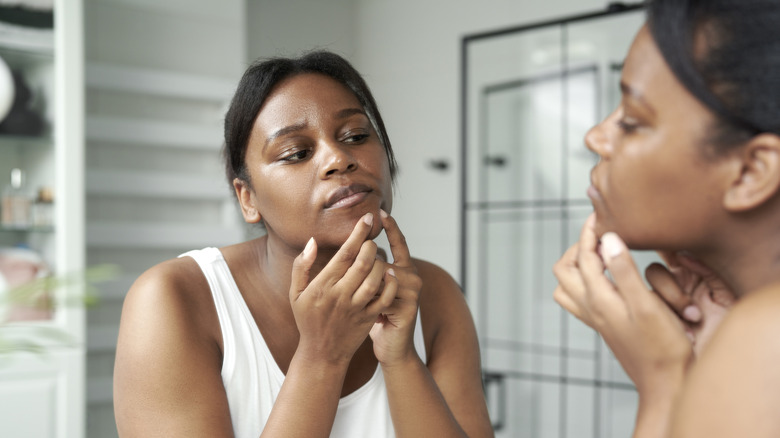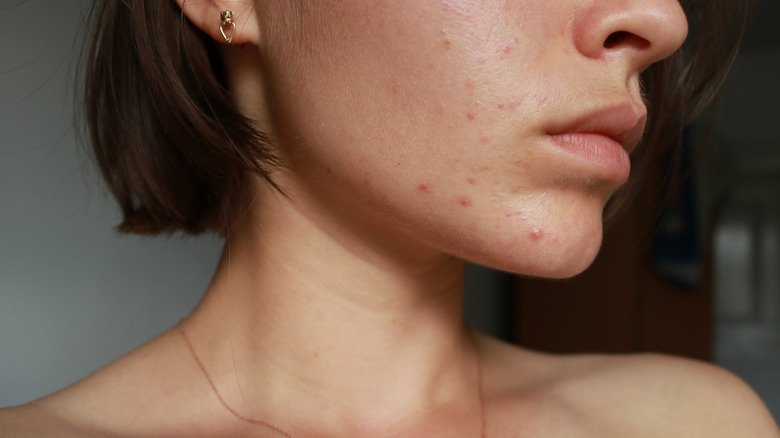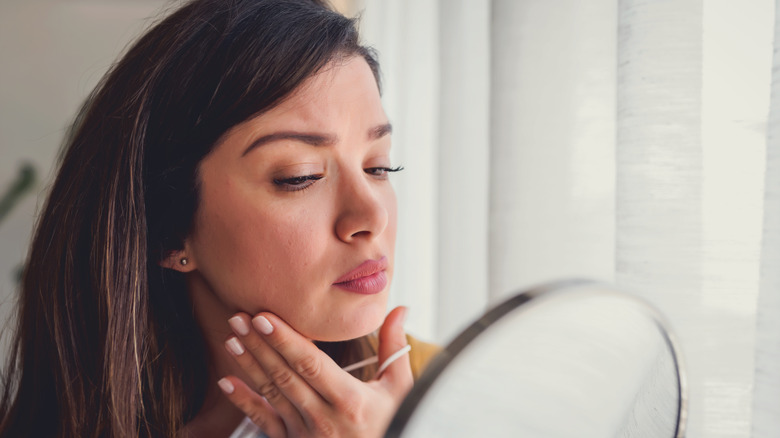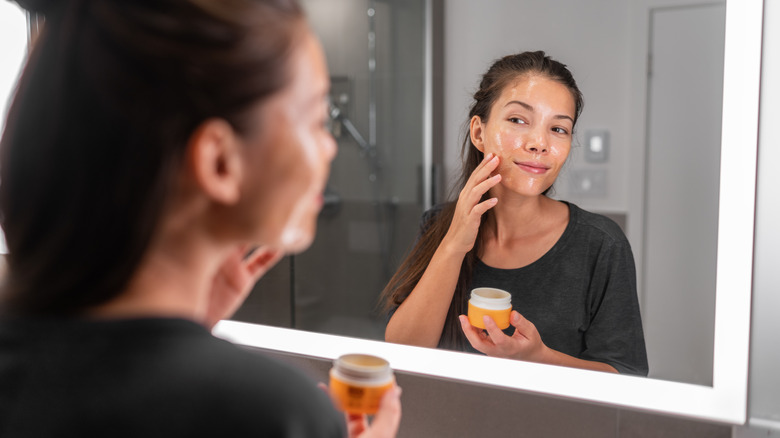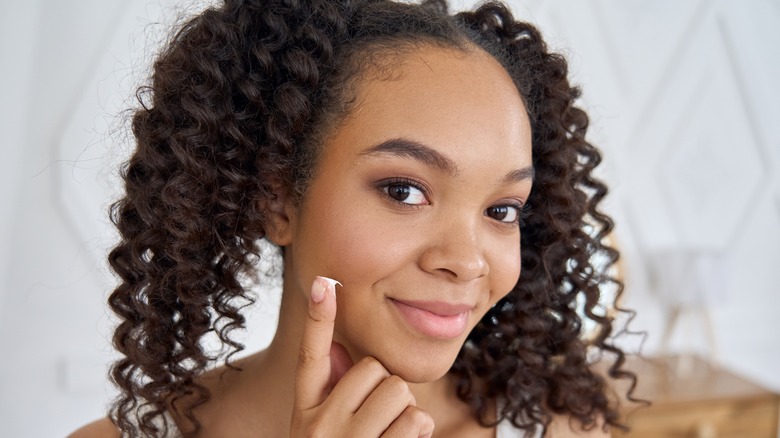How Long Does A Retinol Purge Typically Last?
Initially heralded as a miracle topical treatment for acne, retinol has developed a stellar reputation as a multifaceted wonder ingredient. Retinol is the name given to gentler, over-the-counter forms of retinoid, but both retinol and retinoids can increase cell turnover rate for healthy, smoother-looking skin. These vitamin A derivatives are revered for addressing myriad dermatological woes, from blemishes and enlarged pores to the first signs of aging. According to 2016 research published in Clinical Interventions in Aging, retinol has been a successful anti-aging treatment since the 1980s, and retinoids have been used in dermatology since the 1960s. Although retinol produces subtler effects than prescription-strength retinoids, it's an increasingly popular ingredient in many anti-aging and brightening skincare products.
Still, using the potent active can lead to unpleasant side effects for those beginning their retinol journey. For new users, typical side effects of retinol use can include peeling, breakouts, and sensitivity. This group of troublesome reactions is often called "the retinol purge." Even Andy Warhol noted in his book, "The Andy Warhol Diaries," that he suffered from the irritating affliction after introducing Retin-A, or tretinoin, to his skincare routine. Although the dreaded purge is considered a rite of passage for retinol users, it's an aggravating process when all you want is clear skin. So, what's expected from this transitory phase — and how long does a retinol purge typically last? Board-certified dermatologist Andrea Suarez, M.D. says, "Usually about two weeks, but no longer than six weeks." But there's more.
Common signs of retinol purging
Maybe you've picked up a retinol cream or serum to treat hyperpigmentation or acne. Or perhaps you're trying out a retinol-infused eye cream to lessen your fine lines. Whatever the case is, your first foray into retinol usage is an exciting time. After all, the glowing before and after pictures from retinol users don't lie, right? But after a few nights of dutiful retinol application, you start to notice flaking or peeling around your nose, and your gentle cleanser or sunscreen suddenly begins to sting your skin. Worse, that tiny blackhead you forgot about has evolved into a full-blown whitehead — and what's up with that angry breakout on your jawline?
If any of these symptoms sound like your experience with retinol, you could be experiencing a retinol purge. Because retinol speeds up the skin cell turnover rate, you may notice several issues developing immediately as you use them regularly. Dormant blemishes may come to a head, dead skin cells start to slough off rapidly, and you might notice duller or oilier skin as your complexion begins working overtime. Although this process isn't exactly fun, your skin must get used to consistent retinol usage. That said, it's tempting to quit using retinol at the first sign of trouble — why keep using something that seems to aggravate your complexion? However, it's not unusual for things to worsen before they improve with retinol, and patience is key. Those who continue treatment will be rewarded with radiant, clear skin.
What you should expect during the transitory phase
Naturally, everyone's skin is different, as are their reasons for using retinol. Still, even those who have never experienced breakouts may notice a sudden influx of redness or pimples during a retinol purge. Noticeable side effects like redness, acne, and irritation can last weeks to months before the skin fully adapts to regular retinol usage. Over-the-counter retinol may result in milder reactions, whereas prescription-strength retinoids can have more pronounced effects. If your retinol purge symptoms seem severe or last longer than one to two months, it's best to speak to your dermatologist or aesthetician for additional support.
Numerous factors can influence the length of a retinol purge. It's not unusual to start and stop using retinol or retinoids — in fact, many dermatologists suggest spacing out your nightly applications to reduce sensitivity. "For example, during the first week, apply the retinoid two times a week. Then for week two, apply it three times that week, working your way up to daily use," Dr. Deanne Mraz Robinson tells Healthline. However, inconsistent retinol application can prolong the purging phase for some individuals. Applying retinol too sparingly can have adverse effects as your skin never fully acclimates to the active ingredient, and the purging phase is repeatedly initiated. Thus, it's essential to consult with a skincare professional to develop a retinol treatment plan that works best for your skin.
Common mistakes with retinol usage
Still not seeing the results you'd like from retinol? In addition to an inconsistent application, there are a few reasons your retinol may not work well. Mixing multiple types of retinoids or retinol simultaneously, for example, can amplify their effects, resulting in increased sensitivity or breakouts. Or, if you use retinol consistently but slack on sunscreen application, you could see several unpleasant side effects, from dark hyperpigmentation spots to flaky skin. "Retinol makes your skin more sensitive to UV rays and sunlight decreases the efficacy of the product," Dr. Whitney Bowe tells Vogue. To counteract this, always wear sunscreen or tinted moisturizer with SPF 30 or higher, and be sure to reapply it throughout the day.
Another common issue is introducing a high-strength product too quickly in your retinol journey. Although it's easy to think that more of an active ingredient is better, incorporating lower-strength retinol into your routine at a slower pace may be more beneficial for your skin. Look for products formulated for sensitive skin using over-the-counter retinol, or consult your provider for prescription-strength retinoid products.
Using retinol with other active skincare ingredients can harm your skin barrier. Furthermore, combining retinol with other ingredients could negatively affect your outcome. Some ingredients, like AHAs or BHAs, should never be combined with retinol or retinoid-based products. It's also worth noting that slugging with retinol can lead to mixed results — while some skin types can tolerate it, others may experience heightened sensitivity or irritation.
What to expect after the retinol purge period
Once you've moved past the retinol purging phase, you can expect dramatic changes in your complexion. You'll know that the retinol purge period is ending when you start to see fewer breakouts, decreased redness, and softer skin. With consistent retinol usage, many users experience fewer blemishes and fine lines. On top of that, as the skin becomes accustomed to retinol, it takes on a noticeably smoother texture and radiant glow due to increased collagen production and antioxidant properties. Beyond dewy skin, you may even notice a healthy flush of color, as continuous retinol use can result in a rosy-looking hue.
Nevertheless, even the most diligent skincare enthusiasts have their off days. If you happen to miss an application or two, you may notice the familiar symptoms of a retinol purge rearing its head again. Experts suggest amping up your skincare regimen to stop a retinol purge. "It is important to wash your skin every morning and night to remove any debris, pollutants, makeup, and skincare residue that might clog your pores while the skin is purging," Edyta Jarosz, licensed aesthetician, tells Women's Health. Sticking with a good face-washing routine, regularly moisturizing, and wearing sunscreen daily are important steps to maintain your results with retinol.
How to care for skin while using retinol
Getting used to retinol in your skincare routine can be challenging, and even long-term retinol devotees may experience sensitivity or irritation from time to time. Retinol has natural exfoliating properties, and harsh actives like AHAs, BHA, and PHAs can be overkill for your skin barrier. Limit your use of active ingredients and abrasive exfoliants to reduce the occasional peeling or flaking associated with retinol. Some skin types may tolerate exfoliants on the same days they apply retinol. Still, others may need peels or enzyme treatments when they don't use retinol to avoid over-exfoliating.
One thing to keep in mind is that exfoliants, from retinol to enzymes, can increase your skin's sensitivity to sunlight. Therefore, you'll want to use a minimum of SPF 30 each day and remember to reapply sunblock every two hours while using them. "When you remove dead skin cells and expose the new, more delicate skin underneath, your skin becomes more susceptible to damage from UV rays," Dr. Deborah S. Sarnoff tells The Skin Cancer Foundation. Of course, it's also key to use gentle, fragrance-free products on retinol-sensitized skin, whether you prefer mild hydrating serums or moisturizing creams.
Powerful ingredients like retinol may require a bit of a learning curve, but they have the potential to transform your skin's appearance with a bit of time and patience. Retinol can also teach us a powerful lesson — sometimes less is more in skincare.
